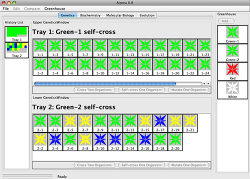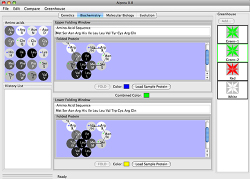Lab Exercises and Manuals
These exercises have been developed over several years and continue to be developed. Feel free to use them,
modify them, etc. as you see fit. If you do modify the exercises, please let me know so I can share this
with other users.
Overview
These lab manuals have been designed to be used in the following order: Genetics, Biochemistry,
Molecular Biology, and Evolution. These sections can be used in any order,
but you will need to revise the manuals so that the activities segue properly.
The first three sessions (Genetics, Biochemistry, and Molecular Biology)
function within an overarching narrative: the quest of a flower company to produce a pure-breeding purple
flower. At each session, students demonstrate the understanding of the mechanism of color formation they
have discovered so far as follows:
- In Genetics, students discover that a blue-red heterozygote is purple; however,
as a heterozygote, it is not pure-breeding.
- In Biochemistry, students discover the rules that govern color formation and use
this to produce a purple protein; however, a protein sequence alone is not sufficient to create a purple
flower - it must be encoded by a gene.
- In Molecular Biology,students discover the differences in DNA sequences
that result in the different color allele. They also discover the DNA sequences required to produce
a protein in Aipotian organisms. They use this knowledge to create a gene capable of expressing a purple
protein. They can then create an organism with two copies of this gene and export it to the
Greenhouse. It can then be exlpored in the Genetics Workbench to show that
it is pure-breeding.
In addition, each group of students generates a mutant strain with a different color and studies this
mutant strain using the tools in each section.
Lesson plans, teaching notes, solutions, etc for each lab can be obtained from
Brian White
Genetics Lab Manual

The Genetics Lab Manual is available from the links below:
In this 3-hour lab session, the students carry out the following activties:
- Learn how to cross and self-cross organims.
- Learn how to interpret the cross results.
- Discover the different alleles in the Greenhouse strains.
- Find the colors produced by combining the alleles.
- Determine the rules that determine the color combinations.
- Use these rules to produce a purple flower (blue/red heterozygote).
- Make a mutant organism with a new flower color and characterize it genetically.
There is no lab report for this session. Students post their results to the class data blog.
Biochemistry Lab Manual

The Biochemistry Lab Manual is available from the links below:
In this 3-hour lab session, the students carry out the following activties:
- Learn how to enter and edit protein sequences.
- Learn how to have Aipotu fold the proteins and determine their colors.
- Learn how to use Aipotu to compare the amino acid sequences of two proteins.
- Discover the different proteins present in the Greenhouse strains.
- Use existing proteins, mutant proteins, and edited protein
sequences, develop hypotheses about the relationship between structure and color.
- Test these hypotheses by building proteins; post results to class blog for regular
“mini-symposia”.
- Reach a consensus as to the relationship between structure and color.
- Using this model, produce a purple protein.
- Use this understanding to explain the color of your mutant from the Genetics section.
In the lab report for this session, each student describes one hypothesis they had, how they
tested it, and the conclusions they drew.
Molecular Biology Lab Manual

The Molecular Biology Lab Manual is available from the links below:
In this 3-hour lab session, the students carry out the following activties:
- Learn how to explore a gene using the Molecular Biology Workbench.
- Learn how to enter and edit DNA sequences.
- Learn the DNA and RNA sequences required for a protein to be produced.
- Learn how to have Aipotu fold the resulting proteins and determine their colors.
- Learn how to use Aipotu to compare the DNA sequences of two genes.
- Discover the different DNA sequences present in the Greenhouse strains
and how they correspond to the different color alleles.
- Using this understanding, devise a gene that produces a purple protein.
- Create an engineered organism with this purple gene and save it in the
Greenhouse.
- Use the Genetics Workbench to create and confirm that you have a
pure-breeding purple strain.
- Use this understanding to explain the color of your mutant from the Genetics section.
In the lab report for this session, each group describes their mutant in terms of its
Genetics, Biochemistry and Molecular Biology.
Evolution Lab Manual

The Evolution Lab Manual is available from the links below:
In this 3-hour lab session, the students carry out the following activties:
- Learn how to set up and start an evolutionary simulation run.
- Learn how to interpret the results of a simulation.
- With mutation turned off, demonstrate Hardy-Weinberg Equilibrium and
natural selection.
- Carry out a series of experiments with mutation enabled that are targeted to specific
misconceptions about evolution.
- Misconceptions
- Selection causes mutations that are adaptive.
- Evolution has a goal.
- Mutations cannot produce new features.
- After many generations of natural selection all
members of the population will have the most favored trait.
- Mutations always reduce the fitness of organisms.
- Experiments
- Start with Green; all colors equally fit. Shows that evolution
is different in each run and that many colors appear in the absence of selection.
Students then explore the sequence differences that led to the new colors and
notice that they are all different.
- Start with Green; select for Black. Shows that, even while selecting for black,
other colors appear. Also, the population never becomes completely black.
- Start with Green with or without selection for Orange. Shows that Orange
appears at different times, but that this is not influenced by selection.
-
- Start with a colorless protein; select for color. This shows that
mutation and selection can lead to the production of new features - in this case,
color.
- Discuss each experiment in terms of how it bears on the different misconceptions.
In the lab report for this session, each student describes one misconception and how the results
from the lab refute that misconception.



